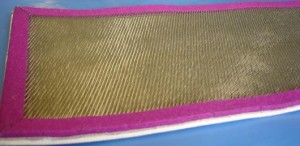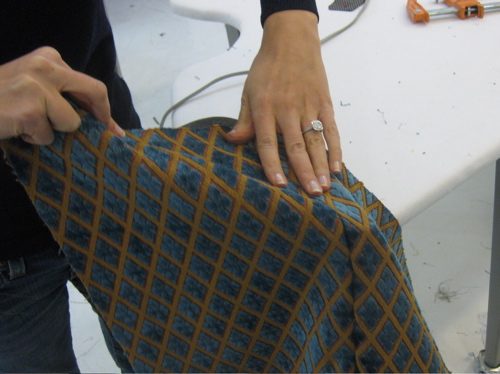Most of the time, when you are sewing with velvet and pile fabrics like corduroy or velveteen a velvet pressing board is the norm.  They are essentially very open velvets made of metal (usually brass) or stable fibers (Dritz makes one that is synthetic rather than metal, but the metal ones are best).
They are essentially very open velvets made of metal (usually brass) or stable fibers (Dritz makes one that is synthetic rather than metal, but the metal ones are best).
This is good for small work, or if the pile isn’t too tricky, but you are still taking the chance that you will apply too much pressure and compress the pile.
This is a real problem if you are working on velvets a lot.
Recently Natalie came to class with a really special upholstery fabric that she wanted to work up into a skirt, so instead of using the velvet board, we showed her (and now you!) how we deal with pressing pile fabrics.
The trick in not compressing the pile is to press from the other side of the fabric. You want the iron to be facing up instead of down and then you pull or push the fabric over the iron instead of running the iron over the fabric.
We stumbled on this idea after seeing an iron from the 1930s that did just this. It was shaped like an elliptical mushroom and mounted to the table with a clamp. After a lot of research, we found this later example from 1951: We were thrilled, but found out that these were not available. Quel. Dommage.
We were thrilled, but found out that these were not available. Quel. Dommage.
What we did was improvise the same setup with two or three C-clamps and our trusty fine-point Rowenta on the edge of our ironing tables.
Now you have to be careful with this, it exposes the face of the iron plate, and of course you will burn yourself if you touch it. So be careful. It also will not work with any of the newer irons that have an automatic shutoff if the iron tips over, so make sure that the iron stays on when inverted.
Take the iron and clamp the handle to the table like this:
 Make sure it doesn’t wobble – Have we mentioned that you need to be VERY careful?
Make sure it doesn’t wobble – Have we mentioned that you need to be VERY careful?
Because you really do.
Once the iron is set up properly and is stable, the technique you use is to run your fabric over the face of the iron from the wrong side.  Natalie’s fabric is thick enough that she can put her hand gently on the face to help it along, but you can’t count on this. Be careful.
Natalie’s fabric is thick enough that she can put her hand gently on the face to help it along, but you can’t count on this. Be careful. 
This method works with understitched facings and details in fine silk velvet as well – you need to be even more careful, and you MUST watch your fingers with smaller detail pieces, but a needle board will never give you as clean of a press as this will:
And there you have it – the better way to press velvets and pile fabrics – be careful, watch your fingers, and have fun.

